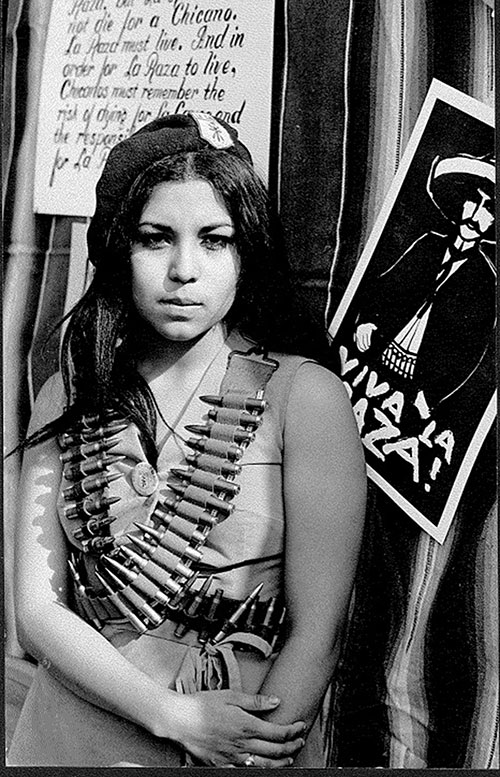Brown Berets
Established by teenagers of Mexican descent, the Brown Berets — a group akin to the Black Panther Party in dress and ideology — played a pivotal role in organizing residents of urban areas during the late 1960s and early ’70s. With a platform that centered the experiences of working-class Mexican Americans dubbed “Chicanos,” the Brown Berets rejected assimilation into European American society and stood against the Vietnam War and police brutality. They also demanded high-quality and culturally relevant bilingual education, helping lead massive walkouts at high schools on the Eastside.
At its peak, the Brown Berets had as many as 55 chapters throughout the country, including the Southwest but also in states such as Kansas and Minnesota. By 1970, however, the founding chapter was tearing at the seams. As the group planned demonstrations against the Vietnam War, female members began to question why they were largely excluded from leadership positions and relegated to behind-the-scenes, menial work.
In 1969, the Brown Berets established the East LA Free Clinic on Whittier Boulevard. Sánchez, who partnered with a health group to find professionals willing to volunteer and serve the community, tasked Arellanes with running the clinic.
Under her direction, the medical center — which was later renamed El Barrio Free Clinic — provided a wide range of medical services, including drug addiction counseling, immunizations, physical exams, STI screenings and even small surgical procedures. Health professionals also provided counseling for unwanted pregnancies.
“And we didn’t say: ‘Have an abortion’ or ‘Do this,’” says Arellanes, underscoring that patients were always informed of all their choices. This resulted in trouble with funding.
“We used to get money from the Catholic Church. And they came one time with a priest and said that they were taking the money away. I said, ‘Fine with me. I’m not going to give up what we do for people.’”
The clinic was also a site of activism. In 1969, the female members joined a hunger strike in solidarity with 26 prisoners protesting conditions at the Los Angeles County Jail.
Founded in Los Angeles in the late 1960s, the Brown Berets were an influential community-based social justice organization that played a leading role in the Chicano Civil Rights Movement of the 1960s and 1970s.
Article from: https://www.laconservancy.org/locations/brown-beret-headquarters
The Brown Berets were originally formed as the Young Citizens for Community Action in 1966 and were active in Los Angeles’ Eastside neighborhoods. The name was changed to Young Chicanos for Community Action in 1967. Members wore brown berets as a symbol of unity and resistance, which inspired the organization’s third name.
The Brown Berets took on a range of social and political issues that plagued the Mexican American and Chicanx barrios of the Eastside in various sectors of life, including educational inequality, healthcare access, police brutality, and wartime casualties. They were active predominantly in the unincorporated area of East Los Angeles, though they also had a strong presence in Lincoln Heights and Boyle Heights.
In addition to their successful marches and rallies one of the Brown Berets' most important accomplishments was the establishment of El Barrio Free Clinic on Whittier Boulevard in 1969.
At the height of their activities in the ‘60s and ‘70s, the organization relocated their headquarters several times as their presence became known to government official and L.A. County Sheriff’s Department, who thought them too radical. For example, the Berets suspected a firebombing of one of their many headquarter locations was conducted by local officers. Their meeting spaces continued to be targets of raids as their activism expanded throughout the community.
The modest building at 2639-41 E. Fourth Street was one of the organization's most significant headquarters, as it served as the Berets' primary meeting location during the planning of the 1970s Chicano Moratorium. The building stands directly across from Theodore Roosevelt High School on Mott Street. The proximity of Beret Headquarters to the high school underscored youth participation in the Chicano Movement.
Built in 1923, the building retains its original design and floorplan as a mixed-use vernacular building, though it has been altered over time. The Brown Beret Headquarters occupied ground floor storefront space for an indefinite period of time after 1968, as the organization faced continuous threats from law enforcement.